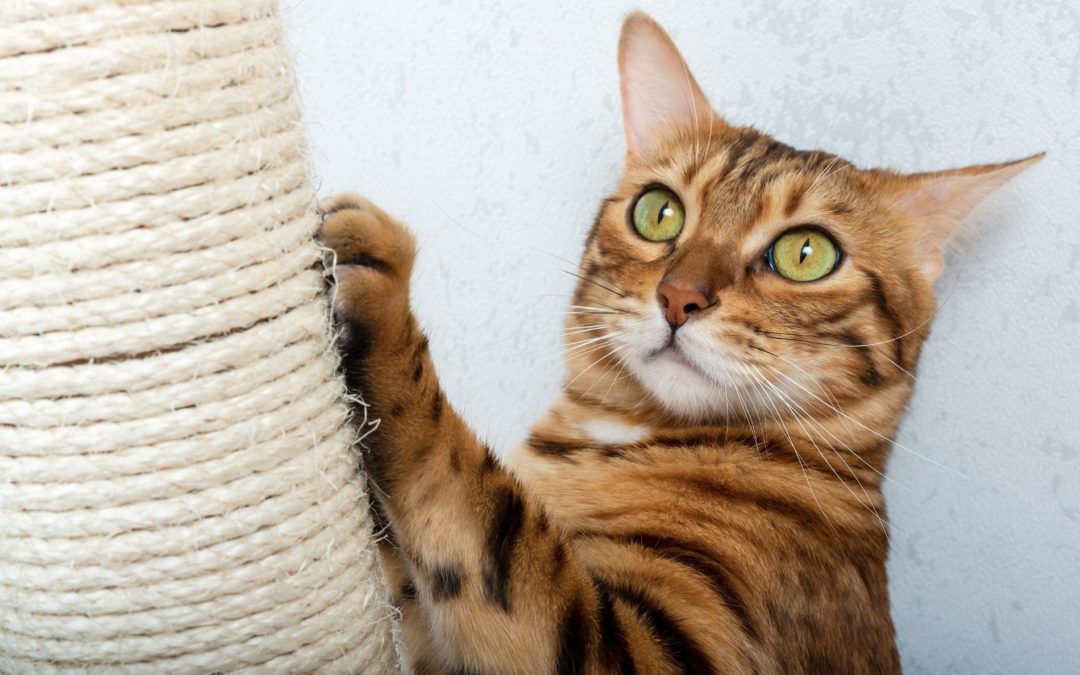Why do cats need to scratch?
When we place a piece of furniture in our home, we mark that as our place. Seeing that item lets us know this space belongs to us. Cats can’t buy their own furniture and out in the wild big cats and feral cats wouldn’t have a place for that anyway. However, all cats have one thing in common, the drive to scratch. When a cat scratches a tree, fence post, their scratching post, or too many owners dismay the items they bought for their own home, they are saying “I’m here! This is my space!”. When we see cat scratches, we see something “destructive”. Cats, however, see that as marking their place in the world. With scratch marks not only can they visually see “I’ve been here” or “another cat has been by here”, their paw pads release pheromones and scent markers that they can smell, but we can’t. Think if you’ve had a cat scratch your bed or couch, you likely spend a lot of time there. It always smells like you, and your kitty wants it to smell like them too! They want to mark this home as their home too.
Another big reason cats need to scratch is that it helps shed dead nail husks. Like filing your nails, scratching helps keep their claws sharp and ready to go hunting or for protection. The act of scratching also helps stretch essential muscle groups for many kitties. When they reach up high to scratch or look like they are doing yoga poses on a horizontal surface they are stretching muscle groups used for jumping, pouncing, and climbing. Cats scratch to serve so many important needs in their lives, it is important that we as their human co-pilots through life help meet this need. At the same time, it is understandable to be frustrated when your favorite things seem to become the target of this communication error.
When is scratching a “problem?”
Scratching is a healthy and normal behavior for felines, but many pieces of furniture are not meant for kitty claws. While we want our kitties to scratch in only certain places, if their humans don’t provide the ones they want, they may look for it where they can. Which includes beds, couches, carpets, and many other soft sturdy items. Our cats tend to prefer soft objects as those hold scents longer, including yours! Your cat wants to show you it is part of your family and without alternative scratchers will turn to the things that smell most like you! They aren’t scratching your bed to pieces to be mean; they are just trying to communicate that they live in your home with you!
Another big issue many guardians deal with is the scratches they receive from their kitties. While many times it is an accident, those scratches still hurt! With aggressive kitties, this can also be detrimental to their bond with their humans. One of the biggest contributors to cats being surrendered to shelters is destructive or aggressive scratching behavior. Aggressive or scared cats with a history of scratching humans will have a much harder time finding new homes and are more likely to be euthanized. Owning a pet means helping to meet their needs, so situations like this don’t have to be a thing.
Tips for living in harmony with kitty claws!
Giving cats lots of alternative options for scratching can help direct their needs more towards what works for you! Cat trees, scratching posts, corrugated cardboard, and many other cat-centered items are made to be scent absorbers and positive places to scratch. Many cats have preferences for vertical or horizontal scratchers, the texture of the scratcher, and where it is located. Making your own cat scratchers is less difficult than you may think! Home Depot has an entire blog with ideas and tips for making your own cat furniture. There are tons of online tutorials using carpet squares, sisal rope, particleboard, and cardboard to make your kitty a unique piece all their own! When learning about your cat and its needs, look at what they prefer now. If they are scratching the couch, is it the top flat part? Or up and down the sides? Is it leathery or soft? When starting out try all kinds of textures and orientations till you find the one that makes your kitty happy to scratch. Something as simple as temporarily duct-taping corrugated cardboard to the wall can make for a happy cat!
Now the tricky question is, how do you stop your cats from scratching table legs and, instead, scratching posts and trees? While many people’s first thought may be to use a squirt bottle when they are scratching your stuff, this can harm the bond you have with your kitty. To discourage claws on furniture, try double-sided sticky tape, contact paper placed sticky side up, aluminum foil, or citrusy smells. These textures and smells are really displeasing to cats and will make them naturally want to stay away from these places.
Now for the positive, getting them to scratch where you want them to. Catnip or catnip sprays work well for kitties who like catnip, while other cats may love treats and attention they get as rewards when you see them use these new pieces! There is also a pheromone-based attractant made by Feliway called Feliscratch. By using positive reinforcement, you’ll notice them gravitate more and more towards the places more appropriate for them to scratch! If you are clicker training your cat (an amazing way to exercise your cat’s mind while building a bond with your buddy), you can also click and reward when you see them near, on, or using the scratcher to further strengthen their desire to scratch there.
Couldn’t I just Declaw-
NO. In the past, onychectomy (declawing) was performed routinely in healthy cats to stop unwanted scratching. What came with this usually ended up being much worse in the long run for kitties and their people. When a cat is declawed, the first toe bone that holds the nail is amputated. Since cats are digitigrade (they walk on their tiptoes), declawing completely changes how they walk, having to use bones that are not meant for full-body support and can lead to arthritis-like pain as well as many new studies showing phantom limb pain in cats. Many times, the surgery can end up causing more medical issues if bone fragments are left in the paw.
The physical aspect of cats isn’t the only part that suffers from declawing. Since walking now causes extra pain, many cats will begin having litter box issues as the litter granules can cause more pain in this now extra sensitive area. Cats may choose to avoid the litter box altogether if they feel the pain isn’t worth it and will choose softer places, like couches and beds. Cats’ claws are also their first and main form of defense; if they get stressed or scared the claws come out first. If these are taken away, cats tend to resort to biting much quicker. Cat bites can become infected extremely easily. What may have been minor scratches on your hands may now turn into full hospital visits. Misunderstood cats that are declawed can be deemed “aggressive” and these cats are more likely to be surrendered to shelters or must be euthanized due to aggression when, in reality, they are just trying to show pain or discomfort and using the only defense option that they have left. For an in-depth look at declawing, check out this YouTube video from Cat Behaviorist Jackson Galaxy: The Truth About Declawing Your Cat
We know so much more about cat health today and it is our responsibility as kitty co-pilots to make the best choices for our friends that we can. There are now lots of alternatives we can use to build a relationship with our cats while keeping those sharp nails in their paws. Building trust with your kitty to trim their nails at home can save you money at the groomers while also getting some quality snuggles with your cat! If that is still a bit difficult, there are products known as kitty caps, or soft claws, that slide on your cats’ nails (like getting fake nails during a manicure!) that come in a variety of colors. Check out a variety here on Chewy. These do need to be replaced fairly often, (and some kitties may not appreciate the feeling), but these alternatives will always be better for your cat’s mental and physical health than declawing.
It can be hard to find that middle ground with your cat when it comes to their need to scratch and your desire to not find the things you own in shreds. It is not only in their nature, but it is important for their health. Hopefully, this blog gave you some ideas of where to start to build a new foundation with those sharp little kitty claws.
Looking to buy?
Cactus Rope and Fabric Scratching Post
Wall Mounted Scratcher
Carpet Scratcher with Perch
Three Sided Corrugated Cardboard scratcher
References:
https://icatcare.org/advice/scratching-on-furniture-and-carpets/

